Last Chance to Catch NYC's Holiday Notalgia Train
We met the voices of the NYC subway on our nostalgia ride this weekend!

See how Flushing Meadows-Corona Park has changed over 60 years by checking out side-by-side photos from the 1964 World’s Fair and today!

This spring, Untapped New York celebrated the 60th anniversary of New York City’s 1964-65 World’s Fair with our Chief Experience Officer Justin Rivers, Queens Theatre, Queensboro Dance Festival, World’s Fair Historian Bill Cotter, and the Queens Economic Development Corporation at a special historic site tour with pop-up dance performances in Flushing Meadows-Corona Park. On August 4th, 2024 at 6:00 PM ET, Queensboro Dance Festival will bring even more performances to the park! This event in front of the Unisphere will highlight dance groups from all over New York City. Each performance will represent a different country or state present at the 1964-65 fair including Hawaii. Mexico, Taiwan. Argentina, and more. This event is free and open to the public!
Below, we’ve created a companion guide for the tour, showing what each stop on the May tour looked like in 1964 with historical photos shared by Bill Cotter, and what it looks like today!
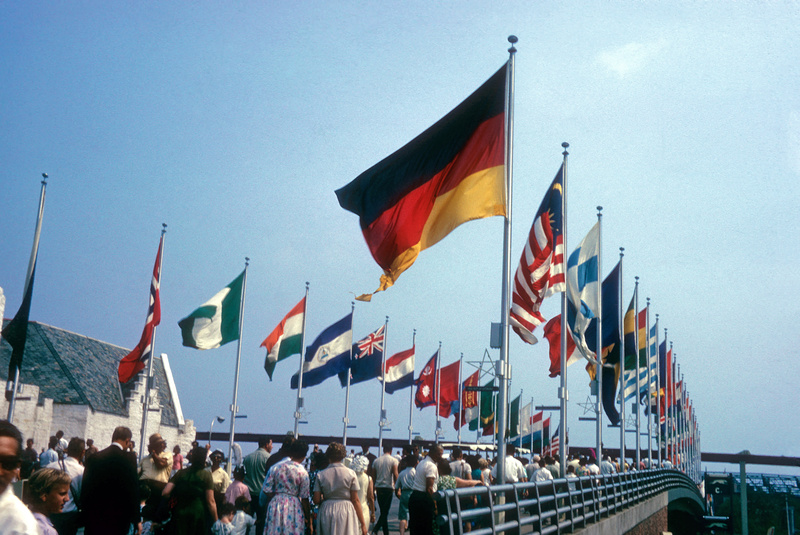
On April 22, 1964, New Yorkers and visitors from across the globe first entered the World’s Fair grounds at what is now Flushing Meadows-Corona Park in Queens. If you entered from the southern parking lots or the city bus terminal and walked across the Meadow Lake Bridge, you would have passed the Astral Fountain and Court of the Stars. Continuing towards the central Unisphere, you’d stroll down the Truman Promenade and along a flag-lined path called the Court of Nations.
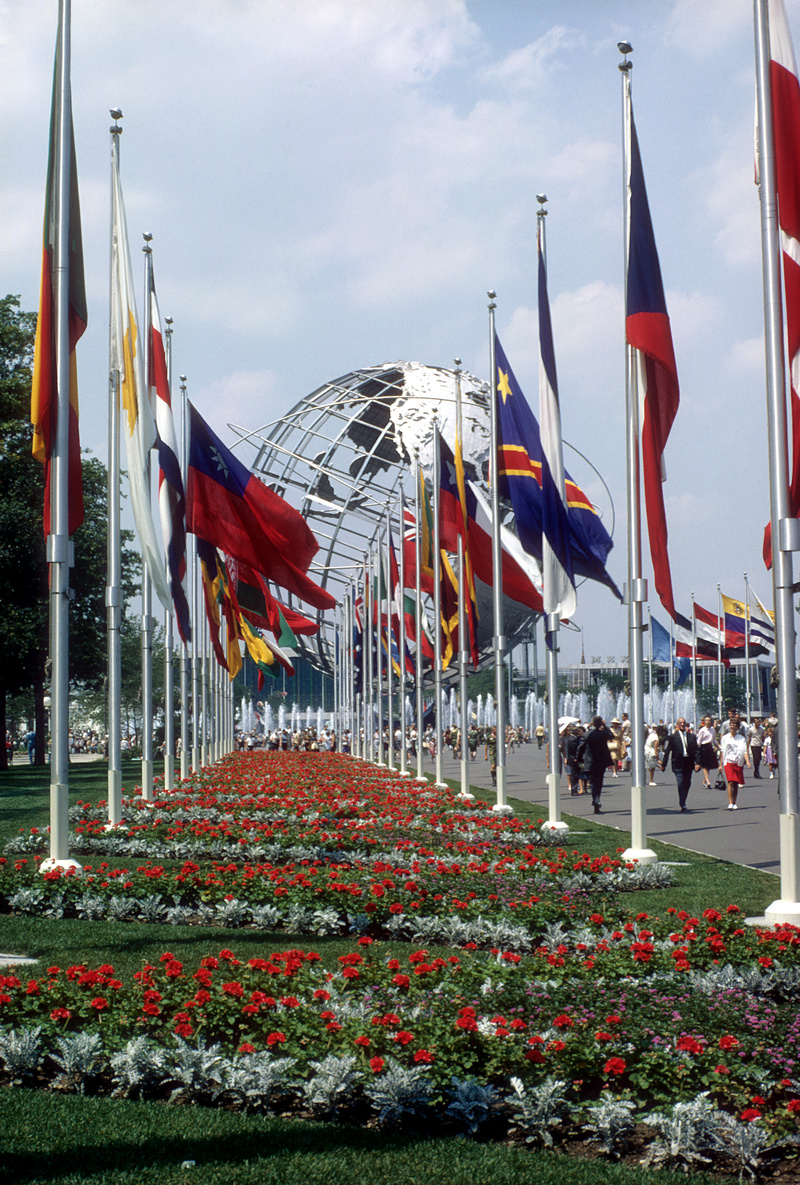
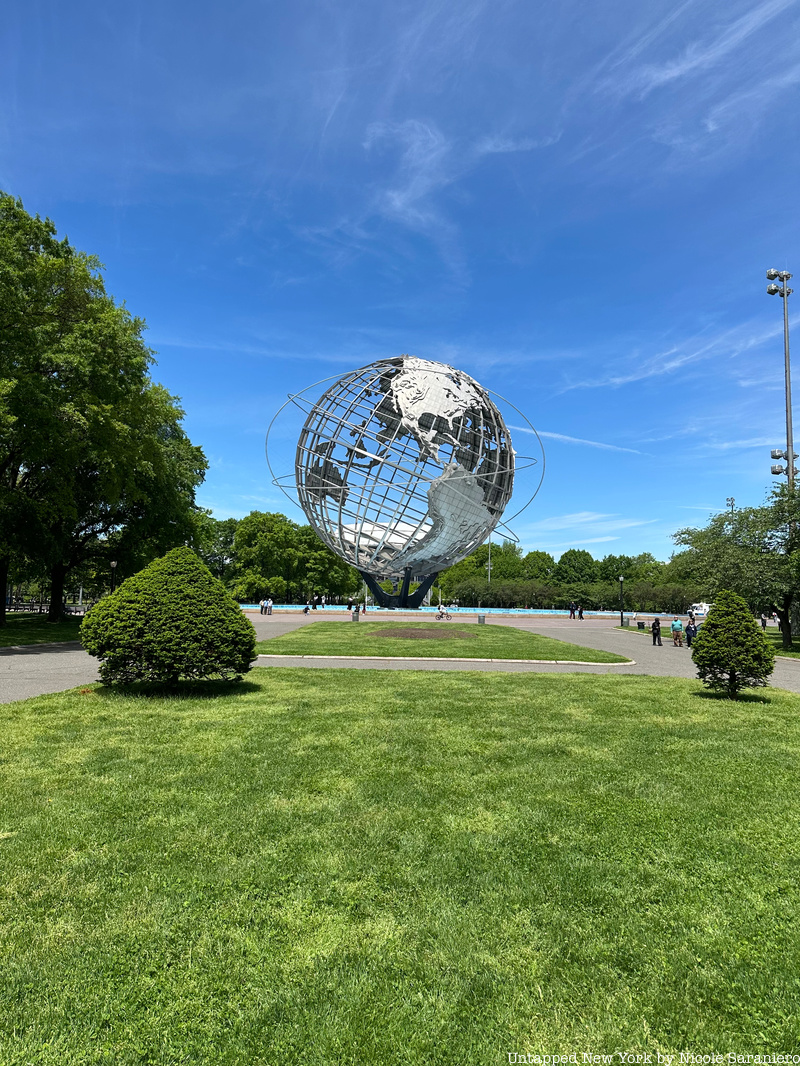
In the International Area of the fairgrounds, there were 37 pavilions—each hosted by a different nation. The pavilions were arranged along the radial street grid first laid for the 1939 World’s Fair. You can still see some street names on the pavement today. In the sixties, everything radiated outward from the Unisphere. The International area extended eastward from the Unisphere to the Avenues of Europe and Asia and stretched south to north from Meridian Road to New York Avenue.
Roughly 80 nations were represented at the Fair, more than were exhibited at any other international exposition before. Visitors got a taste of the diversity of the fair’s offerings as they strolled along the Court of Nations beneath the waving flags. Today, the lawns leading up to the Unisphere along this pathway are green and lush, though there are no longer colorful flowers. The flagpoles were removed and tiny bushes now line the alleyways.
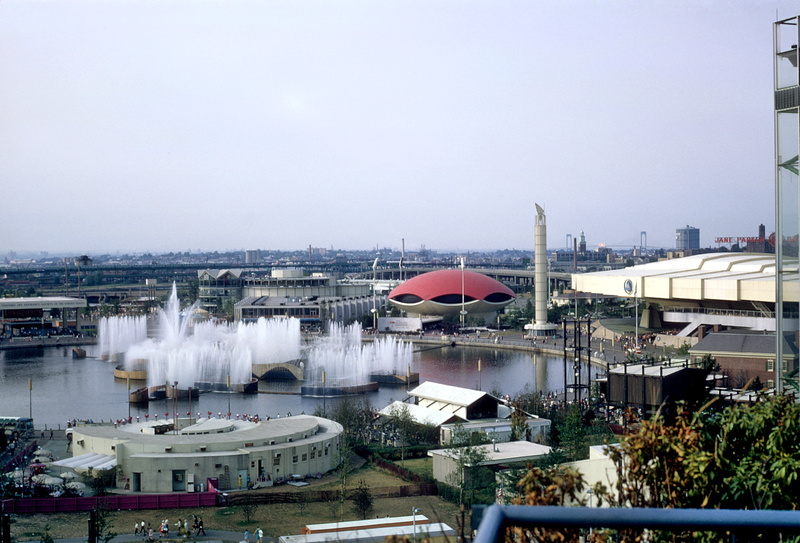
In addition to the stunning pavilions that filled the 1964-65 World’s Fair, there were also stunning water features. Throughout the grounds, visitors could see 11 reflecting pools and nine fountains. The largest and perhaps most spectacular of the fountains was the Fountain of the Planets.
Located due east of the Unisphere, past the Fountains of the Fairs, the Fountain of the Planets burst into the sky from the Pool of Industry. It could be viewed from the Court of the Universe (which you can still see a sign for if you look down) or anywhere along the Promenade of Industry. The pool was ringed by industrial pavilions for companies such as Equitable Life, Traveler’s Insurance (the red umbrella-like structure), Bell System, Clairol, and General Electric.
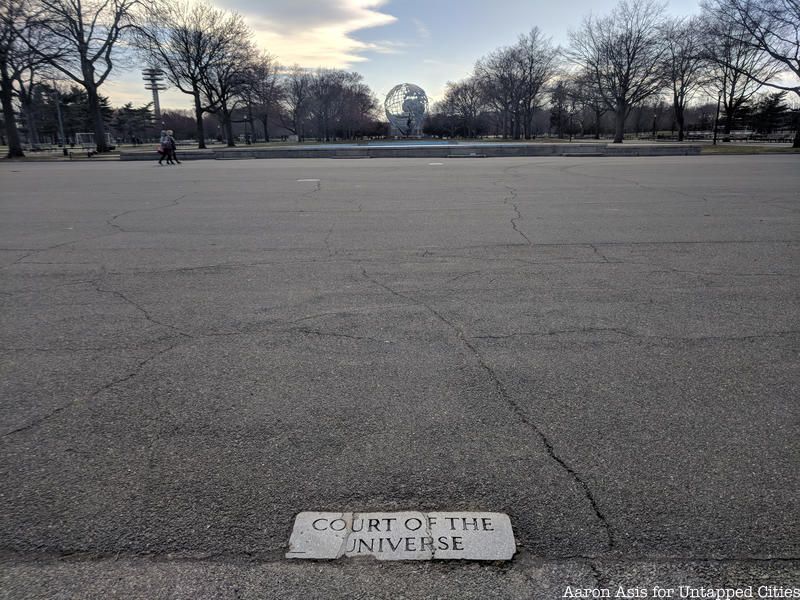
Fountain of the Planets hosted a nightly show with synchronized fireworks, music, color-changing light effects, and water shooting as high as 150 feet into the air. 2,000 powerful water shooting nozzles pushed out 400 tons of water! During the 1939 World’s Fair, the Pool of Industry was known as the Lagoon of Nations.
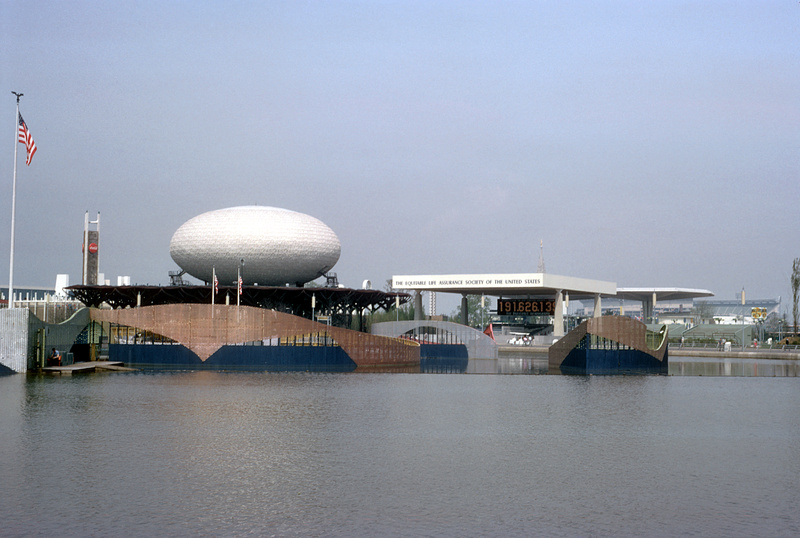
Today, none of the industrial pavilions that once stood around the pool remain. Various sports fields ring the pool today. However, some pieces of the fair buildings did find new life after the fair. General Electric’s attraction “Progressland,” created by Walt Disney, was repurposed as the ride “Carousel of Progress” in California’s Disneyland.
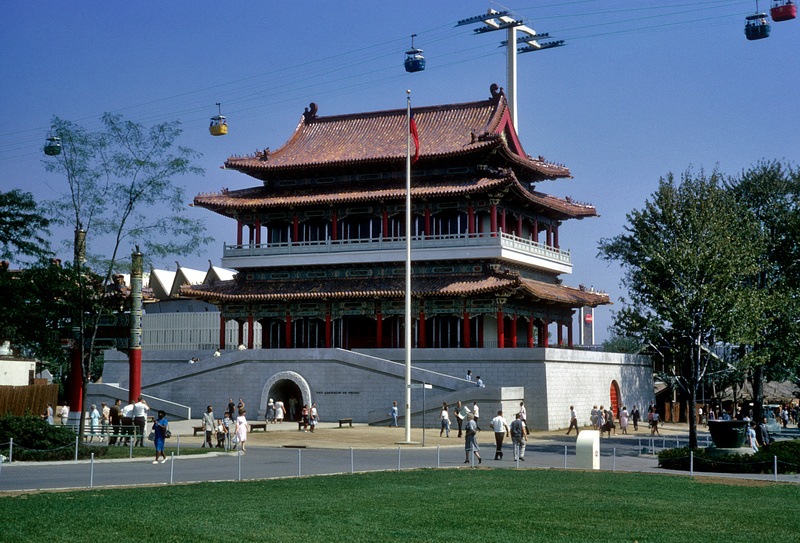
The red and gold palace of The Pavilion of the Republic of China was located in a prime spot just in front of the Unisphere. It stood on a corner along the Court of Peace, next to the Caribean Pavilion and in front of the Polynesian Pavilion. The building was a replica of a traditional imperialist palace in Peking.
The impressive pavilion was made mostly of materials shipped over from Taiwan, including handmade roof tiles. Symbols of good luck including a dragon, phoenix, lion, and unicorn were included in the facade design. The official guidebook for the fair enticed visitors to the site with the promise of viewing more than 400 objects including jade, porcelain, ancient silks, bronze, and calligraphy, some more than 3,000 years old. Today, there is a large field of grass where the pavilion once stood.
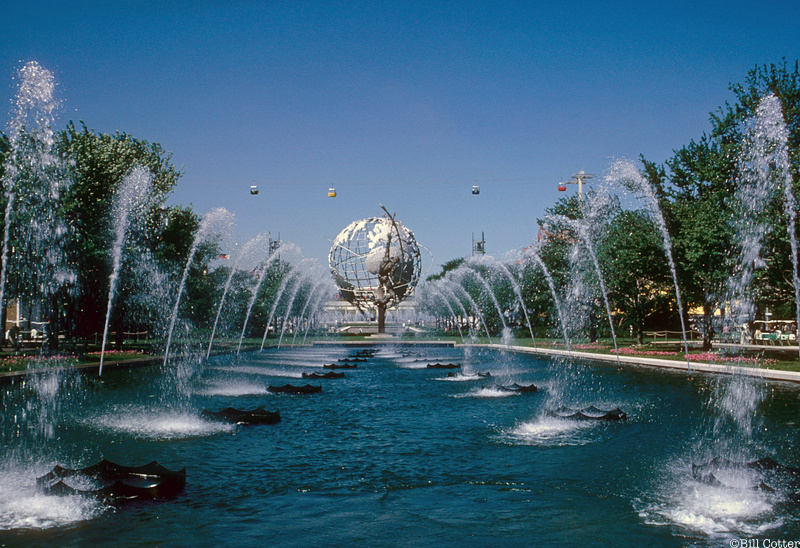
The 43-foot bronze sculpture displayed prominently opposite the Unisphere was designed by sculptor Donald De Lue. Standing in the Court of the Universe at the top of the Fountains of the Fairs, The Rocket Thrower is meant to evoke the fair’s theme of “Man’s Achievement on a Shrinking Globe in an Expanding Universe.” The sculptor depicts a muscular figure hurling a rocket toward the sky while reaching for a constellation of stars with his other hand.
De Lue had just six months to model the sculpture before it was sent to the Fonda Artista in Italy to be cast. The casting process took almost a year and the piece was installed just before the fair’s April opening. Other sculptors chosen to create works for the fair included Paul Manship, Marshall Fredericks, Theodore Roszak, Jose de Rivera, and De Lue.
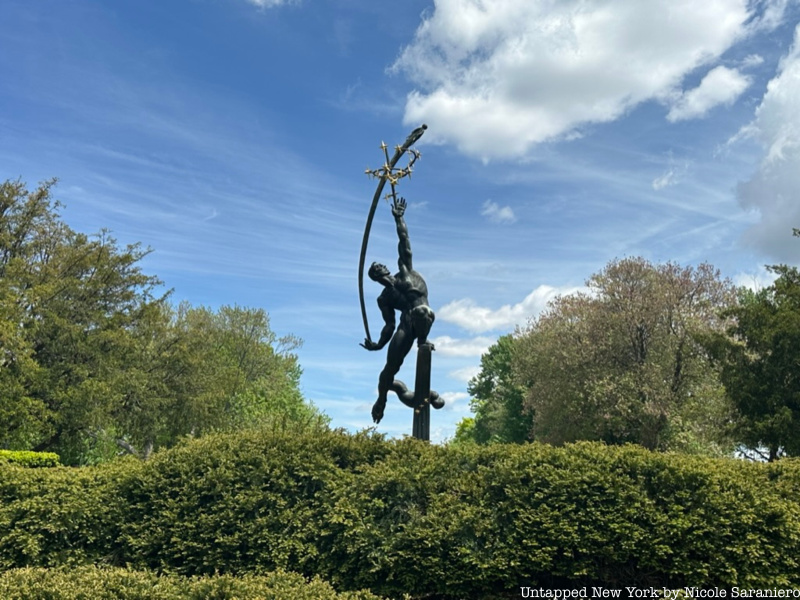
When The Rocket Thrower was unveiled, it was panned by New York Times art reviewer John Canaday who wrote that the piece was “the most lamentable monster, making Walt Disney look like Leonardo Da Vinci.” Robert Moses, the Fair Commissioner, came to De Lue’s defense, stating that Canaday’s insult was “the greatest compliment you could have…[Canaday] hates everything that is good.”
The sculpture hasn’t moved from its perch since the fair. Restoration work was done in 2013 with funding from the Municipal Art Society’s Adopt-A-Monument program. The bronze figure was cleaned, buffed, and gilded so its golden stars shine brightly once more.
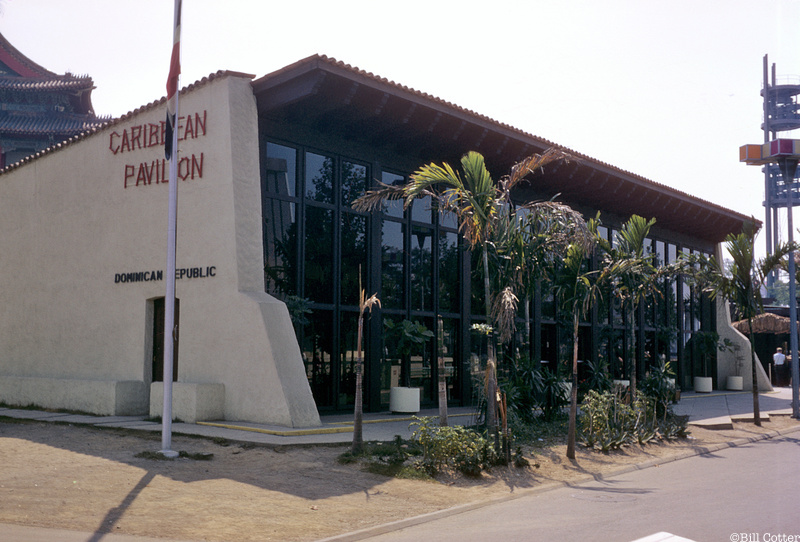
The Caribean Pavilion faced the Unisphere in the first row of international buildings. The official fair guidebook boasted of the pavilion’s “calypso singers, steel bands, and such handicrafts as tortoise-shell jewelry.” Eight different areas of the Caribbean were presented at the pavilion which consisted of two buildings and a large terrace lined with palm trees. A restaurant at the pavilion served Caribbean dishes and drinks like pumpkin soup, suckling pig, plantains, and coconut milk. Today, like all of the pavilions featured in that first row opposite the Unisphere, the site is covered in grass and trees (not palms!)
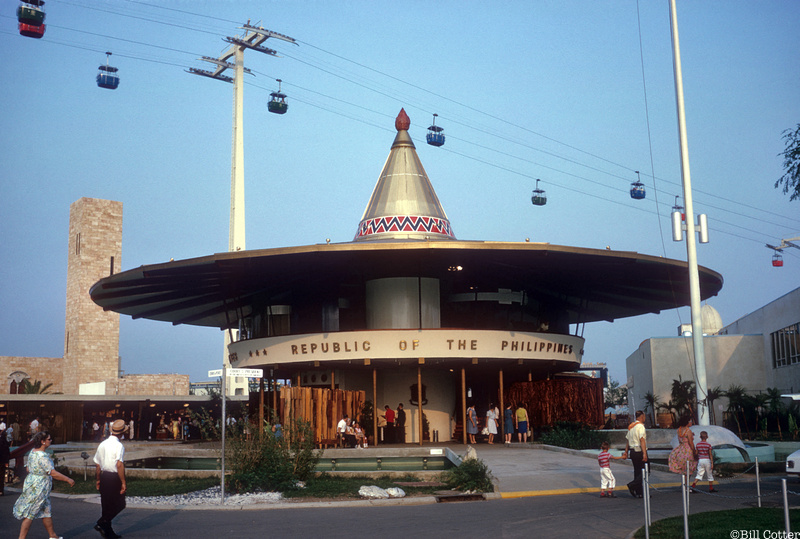
The Philipines Pavilion stood across from the Chinese Pavilion, on the opposite side of the Court of Peace. It also boasted a great view of the Unisphere. The unique building was shaped like a salakot, a wide-brimmed, peaked sun hat often worn in the Philippines. It was surrounded by a moat crossed by three bridges.
The moat contained replicas of World War II battlegrounds, fish native to the Philippines, and seashells. One of the main attractions of the pavilion was a 40-minute dance program that frequently ran in an open-air theater. Today, the site of the pavilion is a sprawling lawn.
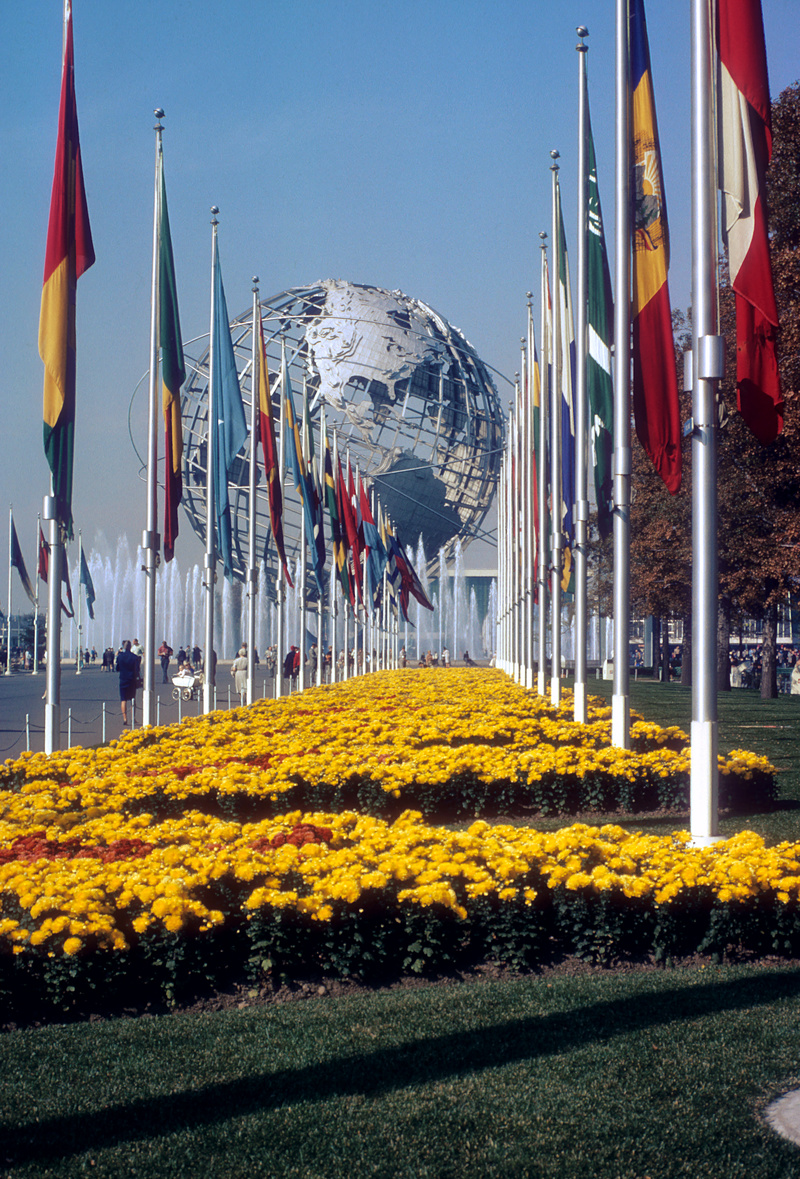
The Unisphere was the centerpiece of the 1964 World’s Fair. This new steel structure was an impressive feat of engineering, set at the former site of the Trylon and Perisphere from the 1939-40 World’s Fair. It is made out of U.S. Steel and was constructed in Pittsburgh by fifty Mohawk steel-workers from the Kahnawake reservation near Montreal. The Unisphere stands 12 stories tall, 120 feet in diameter, and weighs over 900,000 pounds. It is the largest representation of Earth, on Earth! It shows what Earth looks like from 6,000 miles away in space. Each nation’s capital is marked by a light.
Unlike most of the other structures built for the Fair, the Unisphere was meant to be permanent. Surrounded by the Fountain of Continents, the globe appears to be floating when the fountains are on during the summer months.
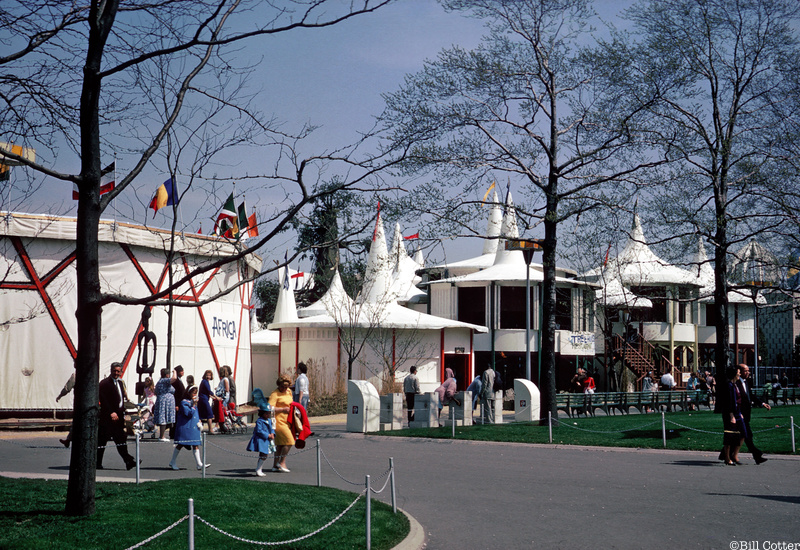
Another front-row spot at the Unisphere was occupied by the African Pavilion. This pavilion wasn’t just one large building but a village of 24 round huts. Based on an ancient design but constructed of modern materials like plastic and wood, each hut represented a different nation of sub-Saharan Africa. A giant model of a banyan tree towered over the huts. This tree contained a tree-house restaurant where visitors could indulge in “African dishes modified for the American palate.” Other attractions included live animals like lions, leopards, antelopes, zebras, monkeys, giraffes, and exotic birds, exhibits of folk art, weapons, and masks, and an open-air theater where visitors could watch Watusi dancers and Burundi drummers.
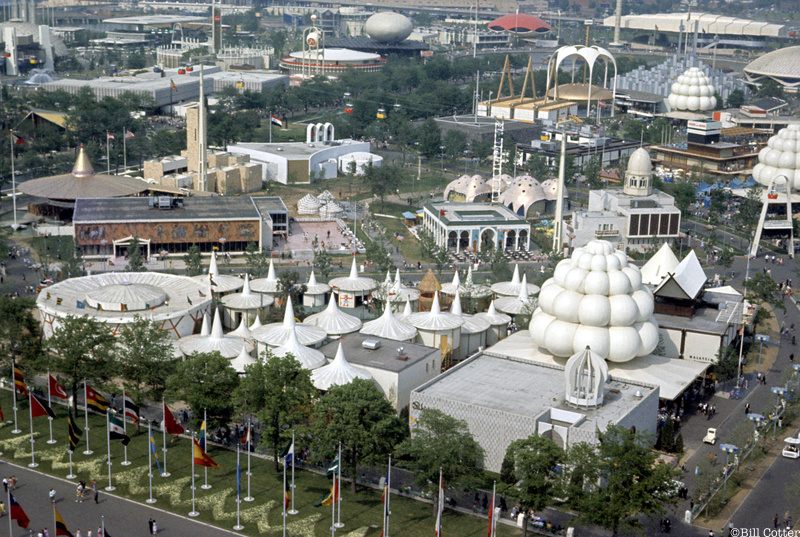
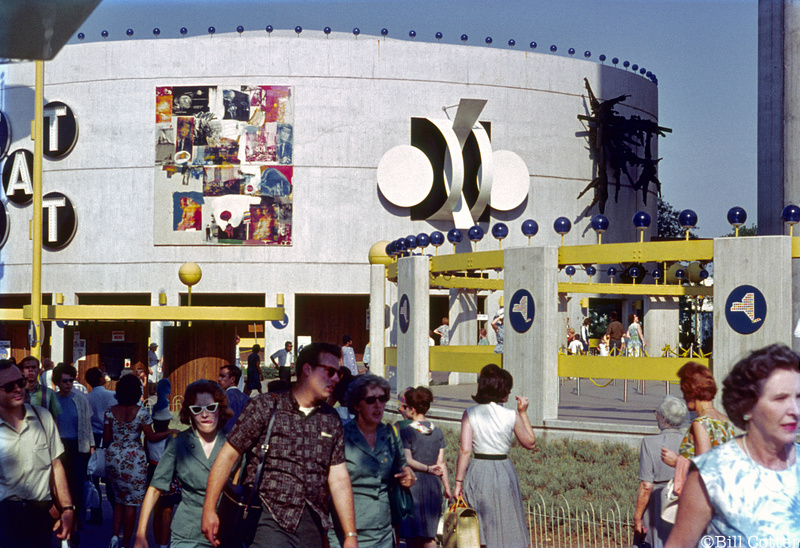
The New York State Pavilion was made of three structures designed by noted architects Philip Johnson and Richard Foster: The Tent of Tomorrow, a trio of Observation Towers, and Theaterama. Theaterama was a cylindrical building covered in large works of modern art by Andy Warhol, Roy Lichtenstein, Robert Rauschenberg, and Ellsworth Kelly. Inside, visitors watched a 360-degree panoramic film on the State of New York.
Nearly a decade after the fair, the theater was converted from a movie house to a live theater space. Queens Theatre was officially established in 1989 and in 1993, after a $4 million renovation, the theatre opened with a gala event. In 2013, the theater was transformed once more, this time with the addition of the spiraling glass lobby we see today.
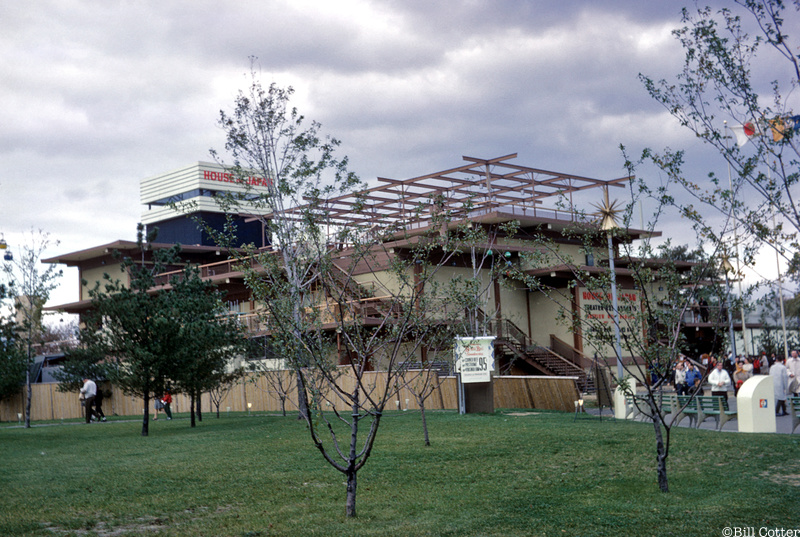
The Japan Pavilion embodied the best of old and new Japan. Displays inside showed off innovations in rockets, cameras, microscopes, and cars as well as celebrated time-honored cultural traditions like tea ceremonies, flower arrangements, and Japanese-style dining. There were three buildings at the pavilion, the House of Japan which contained restaurants, a building containing the Century of Progress exhibit, and a building filled with goods for purchase that represented the new Japan.
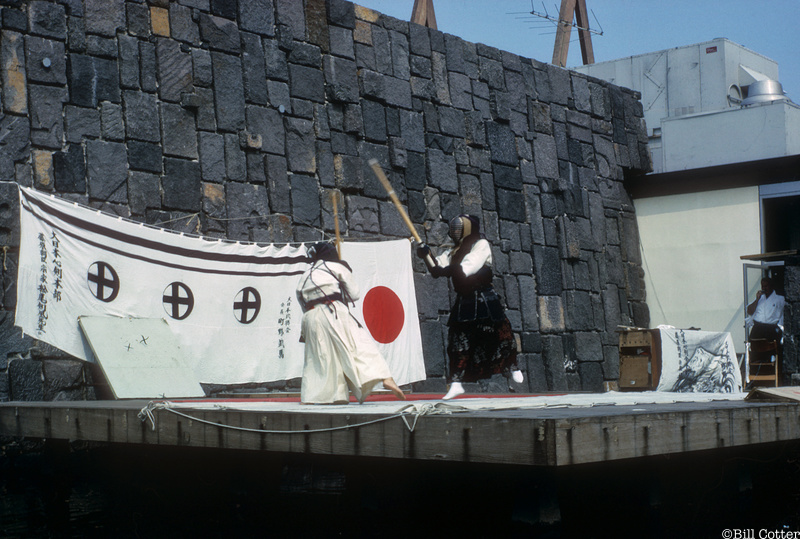
An outdoor stage at the pavilion hosted fireworks, dance, and fashion shows as well as demonstrations of martial arts. Aikido was first introduced to the United States at the fair when it was demonstrated by the late Yoshimitsu Yamada. The pavilion was located next to the Court of Astronauts. Today, a soccer field occupies the site.
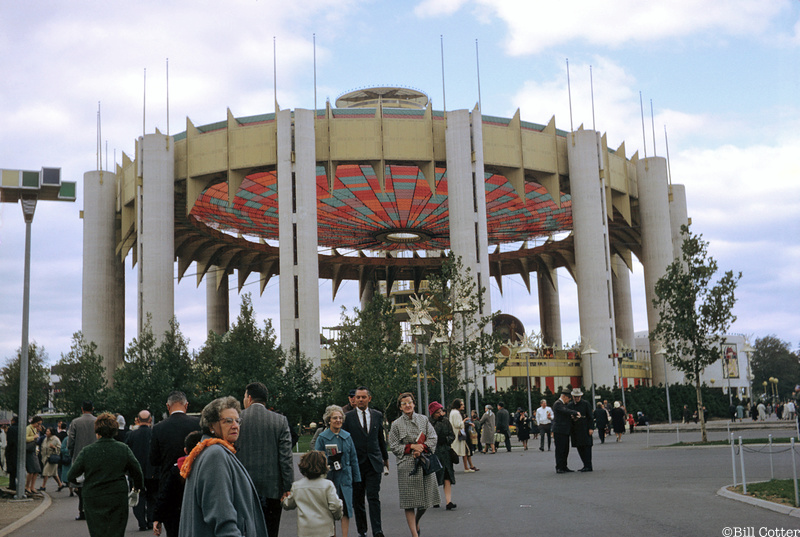
This circular structure once boasted the world’s largest cable suspension roof (50,000 square feet) which supported a dazzling display of multi-colored fiberglass tiles. On the floor of the Tent of Tomorrow, there was a massive 567-panel terrazzo road map of the state of New York provided by Texaco Oil Company. Peeking just above the roof of the tent, you can see the tops of the Observation Towers. The tallest tower was the tallest point at the fair. Visitors could ride an elevator to the top and peer out over a view of New York, New Jersey, Connecticut, Long Island, and the Atlantic.
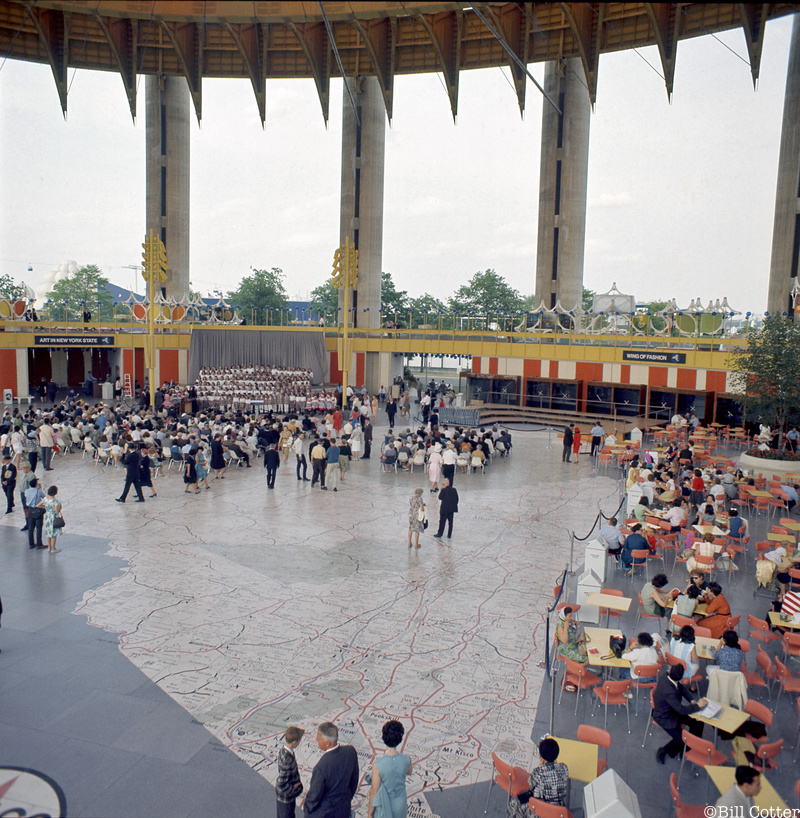
When the fair ended, there was much debate over what to do with the Tent of Tomorrow, save it, or knock it down. Eventually, ownership of the Pavilion was transferred to the City of New York, and the Tent of Tomorrow was preserved. It was temporarily used as an outdoor concert venue and briefly served as a roller skating rink before closing in 1974. For decades after, the Pavilion sat abandoned and deteriorating. Today, the structure is currently the subject of a $24 million restoration project that began in 2019.
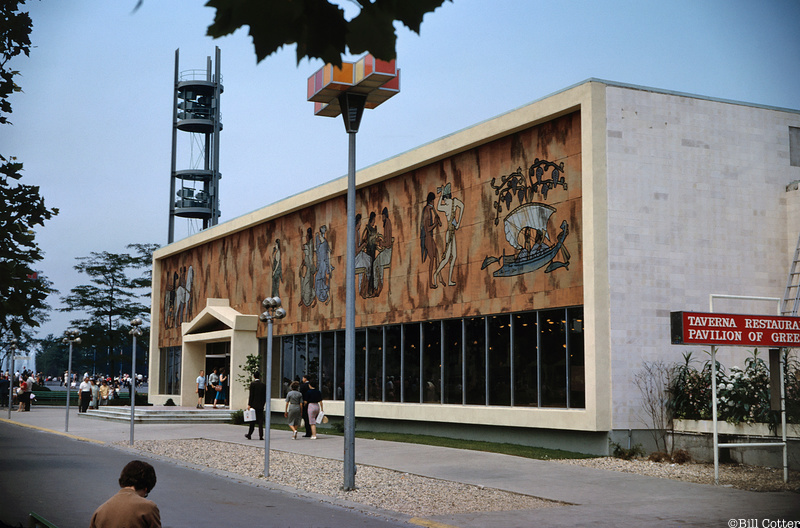
The Greece Pavilion stood right next to the Philipines Pavilion across from the Unisphere. In the style of ancient Greece, the entrance to the pavilion was topped with a pediment and a 120-foot-long frieze decorated the facade. A statue of Zeus stood guard at the entrance. At the Taverna Restaurant, diners were entertained by wandering singing performers. Today, the echoes of ancient Greece have faded and a green lawn remains.
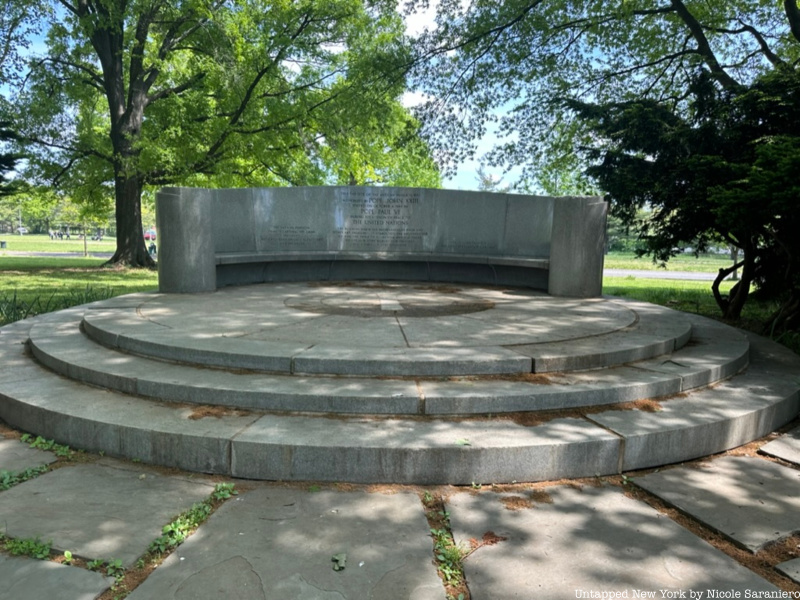
The Vatican bench, also called The Excedera, sits in the shade of tree branches just east of Maloof Skate Park. This monument marks the former site of the Vatican Pavilion and honors Pope Paul VI’s visit to the fair on October 4, 1965. While at the fair, the Pope saw Michelangelo’s Pietà on display at the Vatican Pavilion behind bulletproof glass.
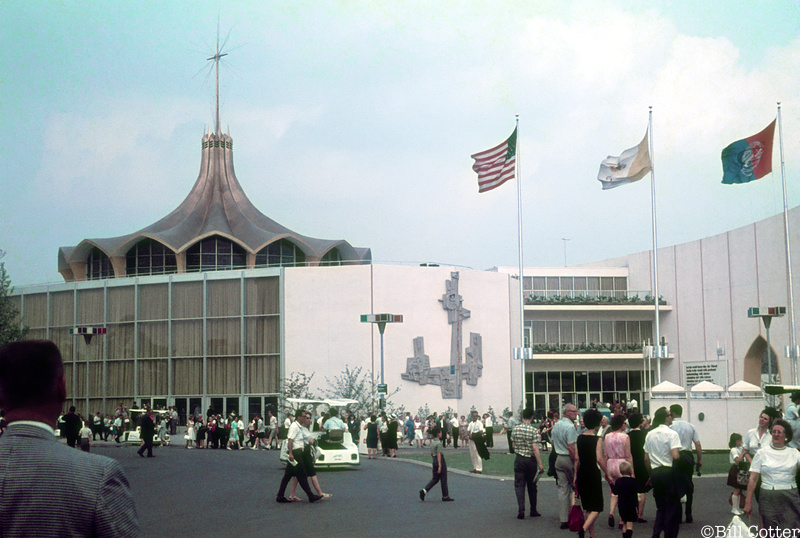
This almost hidden bench, called The Excedera, is featured prominently in The Power Broker, the doorstopper biography of Robert Moses. Author Robert Caro set the final dramatic scene of the book at the bench’s dedication ceremony.
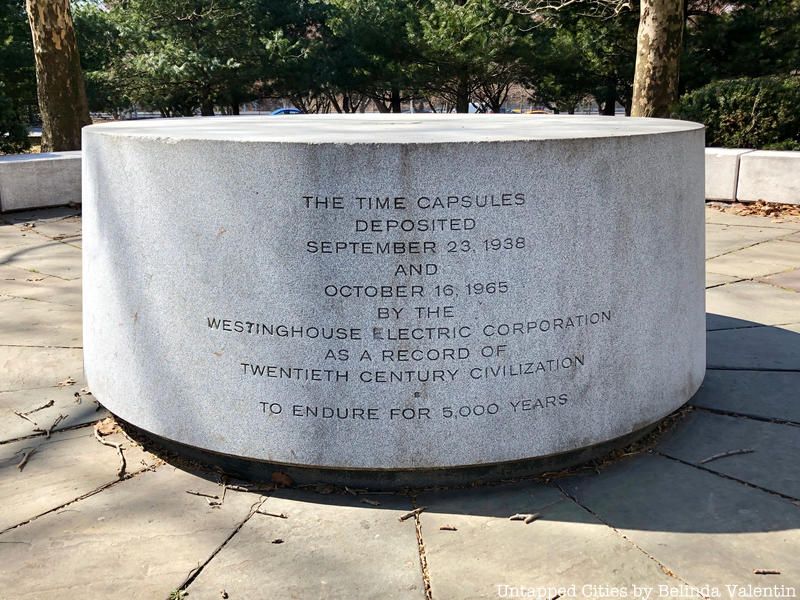
There are two time capsules buried deep beneath Flushing Meadows-Corona Park. The first was buried on this site behind the New York State Pavilion during the 1939 World’s Fair. As a result, the Westinghouse Pavilion for the 1964 Fair was built here among the State Pavilions, rather than in the area around the Pool of Industry. The Westinghouse Pavilion consisted of three open-sided, circular buildings, each representing a different epoch in history. Suspended in the middle of this trio was a steel torpedo-shaped tube, the time capsule. Inside the 50-foot-long tube were credit cards, contact lenses, an electric toothbrush, antibiotics, synthetic fiber, and a Beatles record, among other items. On the second to last day of the fair, the capsule was lowered into the earth, set to be open 5,000 years later.
This granite marker stands above the site of the 1939 time capsule. The 1964 capsule is buried just a few yards away. During the 1964-65 fair, the base of the marker was filled with water to create a shallow reflecting pool. While the Westinghouse Pavilion is gone and the reflecting pool drained, the times capsule site remains largely unchanged.
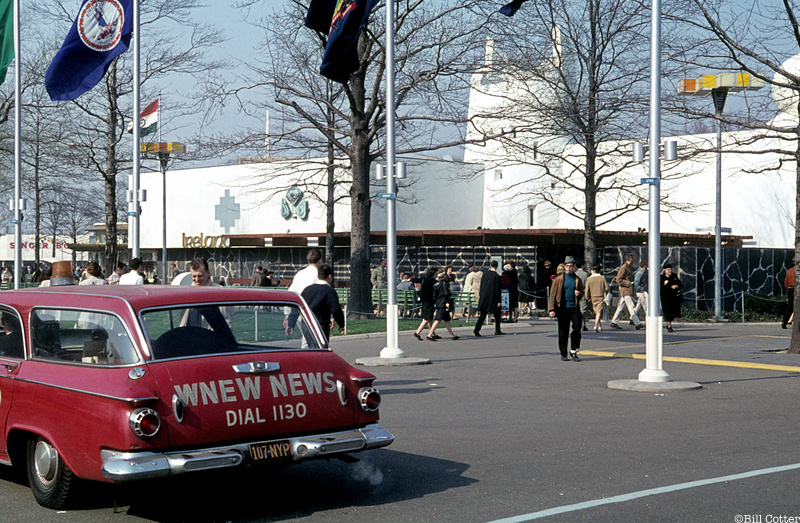
The Ireland Pavilion is one of the handful of international pavilions whose sites are now occupied by the USTA Billie Jean King National Tennis Center. During the 1964-65 World’s Fair, there was a stadium just outside the international pavilions, called the Singer Bowl. The US Open moved there in the early 1970s and it was renamed Louis Armstrong Stadium shortly after. In 1997, Arthur Ashe Stadium opened next door and Louis Armstrong Stadium was demolished. Today, just across United Nations Ave where the Ireland Pavilion once stood, there is a fence that marks the edge of the tennis complex.
The Ireland Pavilion was wrapped in a wall made of Lisconnor gray stone and a reddish brown marble. The identifying architectural feature of the building was a medieval round tower with a modern spin that paid homage to the castles of the Emerald Isle. An open-air theater hosted dancers and singers that visitors could watch while sipping on an Irish coffee.
Join Untapped New York, Queensboro Dance Festival, and Queens Theatre on May 26th at 2PM ET to relive the excitement of the fair as we explore these sites and watch dance performances! Learn more about this free anniversary event here.
Throughout the summer, you can join Untapped New York for more World’s Fair discoveries on our walking tour of World’s Fair remnants in Flushing Meadows-Corona Park!
Next, check out Remnants of the 1964 World’s Fair and see more photos from the fair on Bill Cotter’s website!
Subscribe to our newsletter